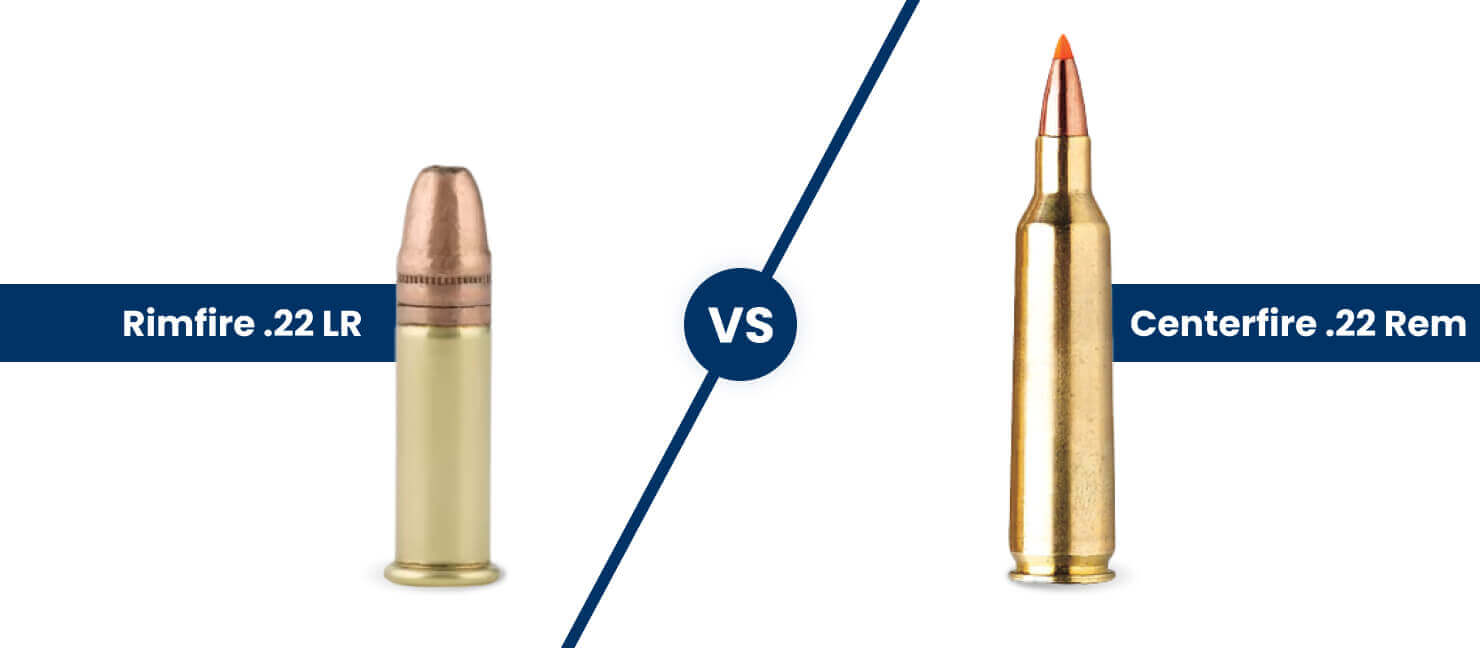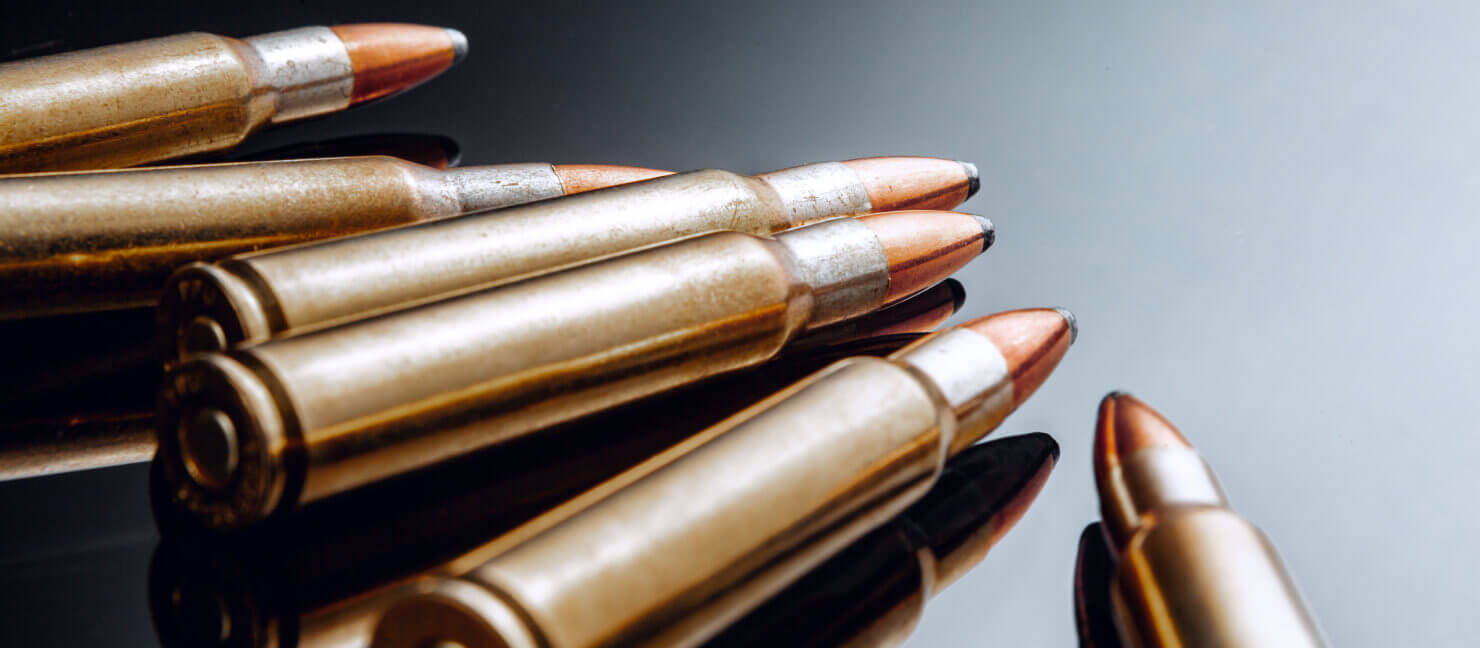Rimfire vs Centerfire Ammo: What’s the Difference?

Load up on ammo knowledge with our straightforward guide for rimfire and centerfire ammunition. Whether you're shooting for fun or sport, understanding the difference between these two can make all the difference. Keep reading to learn more about the key features of each type of cartridge and decide which one is right for you.
Key Takeaways
- Rimfire vs Centerfire: Key Differences — Rimfire shots have less recoil, noise, and reliability. Centerfire shots have more range and versatility but are more expensive.
- What Is Rimfire Ammo? — Rimfire ammunition contains the primer in the cartridge's rim. It is typically used in smaller calibers, making it ideal for inexpensive training, recreational shooting, and small-game hunting.
- What Is Centerfire Ammo? — Centerfire ammunition uses a primer in the center base of the cartridge. This design supports various applications, including home defense, big game hunting, and precision shooting.
- When to Use Rimfire or Centerfire — Rimfire ammo is best suited for situations requiring low cost and stopping power or target shooting. Centerfire ammunition is preferred for more serious applications that demand higher reliability, stopping power, and versatility.
- Rimfire vs Centerfire: Pros and Cons — Rimfire ammunition is cost-effective and suitable for light shooting activities but lacks the power and reliability of centerfire, which offers greater versatility and is essential for demanding shooting tasks.
- Which One Should I Choose? — Choose rimfire ammunition for affordable, low-recoil shooting experiences like practice sessions, recreational shooting, and small game hunting. Go for centerfire ammunition when you need higher power, reliability, and versatility for self-defense, big game hunting, or competitive shooting. Both are used for specific classes of competitive shooting.
Rimfire vs Centerfire: Key Differences

There are several key differences to know about rimfire and centerfire cartridges before making a purchase. Rimfire rounds tend to be less reliable, and cannot be reloaded. However, rimfire rounds and firearms are much more affordable than centerfire, so they’re great for small game and target practice.
Centerfire rounds are more reliable and versatile but keep in mind the higher price point. Remember that these rounds come with more power, so they will have higher recoil and noise. Take a look at our chart for a quick comparison.
| Rimfire vs Centerfire: Key Differences | ||
|---|---|---|
| Category | Rimfire | Centerfire |
|
Recoil |
Low |
Higher |
|
Noise Level |
Generally lower |
Generally higher |
|
Reliability |
Lower due to occasional duds |
Higher, more consistent ignition |
|
Reloadability |
Not reloadable |
Reloadable (brass only) |
|
Caliber Range |
Mostly small calibers (.17 to .22) |
Wide range (.22 to .50 BMG and beyond) |
|
Best Used For |
Training, plinking, small game hunting, practice |
Self-defense, hunting, long-range shooting |
What Is Rimfire Ammo?

The difference between rimfire and centerfire ammunition comes down to their ignition systems. In rimfire ammunition’s ignition system, the primer compound is integrated into the cartridge’s rim. This integration eliminates the need for a separate external primer.
The manufacturing process for rimfire ammo involves spreading the primer compound inside the cartridge case’s hollow rim, then adding propellant and seating a bullet on top.
Upon firing, the firing pin strikes the cartridge’s rim. The firing pin compresses the primer compound, which ignites the propellant and sends the bullet through the firearm’s barrel. Fired rimfire cartridges have a distinctive rim pinch mark indicating where the firing pin struck it.
Rimfire Cartridge History
Rimfire cartridges are among the earliest forms of self-contained metallic cartridges. They were developed in France in 1845 as a solution to the limitations of muzzle-loading firearms.
During the American Civil War (1861-1865), rimfire cartridges gained significant popularity. The .22 Short, developed by Smith & Wesson in 1857, became one of the most well-known rimfire cartridges of the time.
Following the Civil War, the popularity of rimfire cartridges continued to grow. Manufacturers like Winchester and Remington began producing a variety of rimfire calibers, including the .22 Long Rifle (developed in 1887), which remains one of the most popular and widely used rimfire cartridges to this day.
Although rimfire cartridges aren’t as popular as centerfire cartridges, they are still widely used for target shooting, plinking, and small game hunting.
What Is Centerfire Ammo?

Centerfire ammunition uses a primer within a metallic disk. This disk is placed in a designated cavity at the cartridge base to ensure secure placement through friction. There are primarily two primers used in centerfire ammunition: Boxer and Berdan. Both are compatible with general centerfire firearms without distinction for the average shooter.
The action of firing a centerfire cartridge involves the firearm's firing pin striking this primer to ignite the propellant.
This type of ammo is typically found in larger calibers. Centerfire ammo is commonly used for home defense, big game hunting, and precision target shooting. Centerfire's design allows for more versatile applications and is preferred for activities requiring higher power and longer distances, thanks to its robust construction and larger caliber options.
Centerfire Cartridge History
The concept of centerfire cartridges came about in the mid-19th century as an improvement over rimfire designs. One of the key developments in centerfire cartridge technology was the invention of the Boxer primer in 1866. The Boxer primer quickly gained popularity and became the standard for centerfire cartridges.
Centerfire cartridges gained widespread adoption by military forces worldwide due to their reliability and performance over rimfire cartridges. The French Chassepot rifle, introduced in 1866, was one of the first military firearms to utilize centerfire ammunition.
Over time, standardization efforts led to common sizes, shapes, and performance characteristics for centerfire cartridges. This standardization allowed for mass production, interchangeability between firearms, and the development of new firearm designs. They are now known for being reliable, powerful, and versatile firearms for military, sporting, and civilian use.
When to Use Rimfire
Rimfire ammo’s affordability is ideal for extensive practice sessions, recreational shooting, and stocking up on ammunition. This type of ammunition is well-suited for small game hunting, like squirrels and raccoons, and is popular in sport shooting and casual plinking. Rimfire ammo is also commonly used in Olympic shooting events and in historical reenactments.
Reloading Considerations
Reloading rimfire cartridges is generally not possible due to their design. With the primer located in the rim, it’s not replaceable. The small size and intricate design of rimfire primers make attempts at primer replacement or bullet swagging challenging and unsafe.
Consequently, rimfire cartridges are regarded as single-use items not intended for reloading. Collectors may gather spent rimfire cases for display, but reloading them for practical use is discouraged.
Environmental Considerations
Spent rimfire bullets contain lead, posing risks to wildlife and ecosystems if left in the environment. Lead fragments from discharged bullets can accumulate in soil and water, potentially harming wildlife and contaminating water sources. Wildlife, especially scavengers and predators, may ingest lead fragments, leading to lead poisoning.
Proper cleanup and waste management practices are crucial for reducing environmental impacts. Shooters should always remove any spent casings and collect lead fragments.
When to Use Centerfire
Centerfire ammunition is available in larger calibers, which makes it suitable for home defense, big game hunting, and long-range target practice. Centerfire ammo’s versatility gives it an advantage over rimfire ammunition.
While rimfire rounds can be lethal, centerfire ammunition is generally preferred for self-defense situations due to its higher reliability, greater stopping power, and broader range of suitable firearms. While not as common, they may also be used for long-range precision shooting and big game hunting.
Reloading Considerations
When reloading centerfire cartridges, carefully inspect spent cases for signs of damage and ensure they are properly resized and trimmed to specifications. Accurate measurement and consistency are critical for preventing overpressure or underperformance.
Expert Tip:
Instruction manuals should be consulted for specific instructions when reloading centerfire cartridges, and safety precautions must be followed rigorously to prevent accidents.
Environmental Considerations
Similar to rimfire ammo, the largest environmental concern for centerfire ammo is lead contamination. Shooters should carefully clean up spent casings and use ammo that isn’t lead-based when possible.
Popular Calibers

Understanding the popular calibers available in rimfire and centerfire ammunition can help you make informed choices based on your shooting needs and preferences.
Rimfire Ammunition
The .22 Long Rifle (.22 LR) is the most popular caliber due to its versatility, affordability, and the wide availability of firearms chambered for it. Many favor it for everything from beginner training to small game hunting.
Other notable rimfire calibers include the .22 Magnum (also known as .22 WMR, for Winchester Magnum Rimfire) and the .17 Hornady Magnum Rimfire (.17HMR).
The .22 Magnum offers greater range and power for hunting larger varmints, while the .17HMR is celebrated for its accuracy and high velocity, which makes it perfect for precision small game hunting.
Centerfire Ammunition
The 9mm Luger is the most popular centerfire caliber, prized for its balance between recoil, size, and stopping power, making it a top choice for self-defense and law enforcement.
The 5.56mm NATO and its civilian counterpart, the .223 Remington, are other widely used calibers, especially among AR-15 enthusiasts. They are known for their effectiveness in home defense and sport shooting.
These calibers are just two examples of centerfire ammunition's versatility and power.
Pressure & Reliability
The design differences between rimfire and centerfire ammunition extend beyond the placement of the primer. They also impact the pressure levels each type can safely handle and their reliability.
Rimfire Ammunition
Rimfire ammunition operates at significantly lower pressures than centerfire ammunition, making dead rounds common. .22 ammunition, in particular, is known for being unreliable. This limitation directly results from the rimfire's construction. The casing must be thin enough for the firing pin to crush the rim and ignite the primer.
This design simplifies the manufacturing process and reduces cost. However, it also restricts the caliber size and the power rimfire cartridges can achieve.
Dispersing primer material in the rim can also lead to lower reliability and reduced power. This makes rimfire an excellent choice for small game hunting and recreational shooting.
Centerfire Ammunition
On the other hand, centerfire ammunition can handle much higher pressures due to its design. The centralized primer and sturdier cartridge construction allow for a more consistent and reliable ignition.
This reliability and ability to safely chamber larger, more powerful casings make centerfire ammunition the preferred choice for applications requiring dependability and stopping power.
Rimfire vs Centerfire: Pros and Cons
Rimfire Pros
|
Rimfire Cons
|
Centerfire Pros
|
Centerfire Cons
|
Which One Should I Choose?

If you are trying to make a decision between rimfire or centerfire, read our final recommendations for the top reasons to purchase one of these two ammo styles.
Rimfire Ammunition
Rimfire ammunition is ideal for shooters who prefer less recoil and noise. It is also perfect for teaching new shooters the fundamentals, target practice, certain competitions, and small-game shooting.
Because of its lower cost, rimfire ammo allows shooters of various skill levels and budgets to participate in extended practice sessions and activities. Rimfire ammo's smaller size and weight make transporting and storing it in large quantities easier.
Centerfire Ammunition
Centerfire rounds are a better choice if you prefer higher power and reliability. Centerfire ammunition’s reloadable cases also allow you to customize your loads for specific performance characteristics. For example, its ability to handle higher pressure offers shooters greater velocity and effective range.
Have Fun Out There!
Ready to hit the range after all that ammo talk? Visit Academy Sports + Outdoors to snag the best in rimfire and centerfire ammunition. Whether you're aiming for precision in target practice or gearing up for the great outdoors, we've got the ammo to make every shot count.


